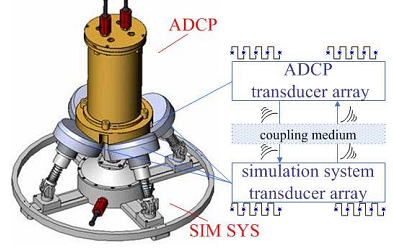In recent years, acoustic Doppler current profilers (ADCPs) have been widely used in oceanographic research and marine application development. And in many cases, it is necessary to ensure that the function of an ADCP is normal before use.
To evaluate the performance of an ADCP, the main way is its self-calibration system and rubbing tests. However, such calibrations are insufficient to cover the whole functionality and performance of the ADCP, especially for profiling range and the velocity calibrations. In most cases, the functionality and performance should be checked in the validation experiments in the lake or the sea. So these high-cost and long-time validation tests are not easily established and more often they are susceptible to environment conditions (e.g. sea depth).
To solve the problem mentioned above, researchers from the Institute of Acoustics, Chinese Academy of Sciences developed an acoustic simulation approach. And this approach provides direct calibrations for ADCP’s functionality and performance under the laboratory conditions.
In the simulation system (Fig.1), a transducer array, using the same number of transducers of an ADCP, is docked with the ADCP transducers face to face through coupling medium. By the transducer array, the simulation system transforms acoustic wave into electric pulse. In this way, simulation system monitors the ADCP transmitted pulse in real time.

Fig. 1 Schematic diagram of the simulation system dock structure (Image by MA).
On the other hand, the simulation system produces simulated acoustic backscatter signal and the backscatter signal can be changed from electric signal to acoustic wave by the transducer array. In the mean time, the backscatter signal simulates the acoustic backscatter of bottom and current when sonar works. According to the profiling range and current velocity information contained in the simulated backscatter signal, ADCP correspondingly feeds back the results of range and velocity. Thus the test environment of an ADCP for functionality and performance is established.
Based on the acoustic simulation approach, an ADCP is calibrated using the simulation system, here is the result in Fig. 2:

Fig.2 Calibration result of ADCP: (a) ADCP velocity magnitude color map in multi-layers (the
depth 0~120 m) shown on the WinADCP software panel, (b) Velocity magnitude of simulation system sets and ADCP results (Image by MA).
Investigating the simulated backscatter signal quality of the simulation system and the ADCP signal also helps to find out the reasons of system failure.
The acoustic simulation system and acoustic simulation method solve the problem of present calibration limitation of ADCP. The simulation system provides a functional and accuracy calibration platform of ADCP under the laboratory conditions. Moreover, using the coupling loss compensation and automatic gain compensation approach, the calibration precision is improved.
The research with the title of "An Acoustic Simulation Approach for Testing ADCP" has been included in the OCEANS ’13 MTS/IEEE San Diego (September 23-26) (130515-003).
Correspondence author:
MA Long
Institute of Acoustics, Chinese Academy of Sciences, Beijing 100190
Email: malong@mail.ioa.ac.cn


